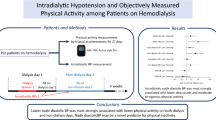Abstract
Purpose
Low levels of physical activity among end-stage renal disease (ESRD) patients are associated with increased risk of hospitalization and mortality, and contributors to low activity levels are important to identify. Among hemodialysis (HD) patients, use of a central venous catheter (CVC) might impede physical activity due to factors such as infection or patient fear of catheter dislodgement.
Methods
This Comprehensive Dialysis Study surveyed patients who had recently started regular dialysis. Physical activity level was ascertained using responses to the Human Activity Profile (HAP) provided by 1,458 HD participants. We examined the association of vascular access type with patients’ scores on HAP subscales measuring self-care and leg effort, two dimensions that are especially important for daily living.
Results
32.6% of patients used an arteriovenous fistula (AVF), 11.5% used an arteriovenous graft, 51.8% used a CVC, and 4.1% used a CVC with another maturing access. Patients’ self-care and leg effort scores differed by vascular access type and receipt of early nephrology care, and the mean self-care score of AVF users who received early care was similar to the mean score reported for healthy adults.
Conclusions
Reported levels of self-care and leg effort activity were higher among incident HD patients using an AVF compared to those using a CVC. Future research should examine whether reinforcing the importance of regular physical activity in the pre-dialysis period, as well as wider early use of AVF in the HD population, may improve physical activity levels among ESRD patients.
Similar content being viewed by others
References
Padilla J, Krasnoff J, Da Silva M, Hsu CY, Frassetto L, Johansen KL, Painter P (2008) Physical functioning in patients with chronic kidney disease. J Nephrol 21:550–559
O’Sullivan D, McCarthy G (2007) An exploration of the relationship between fatigue and physical functioning in patients with end stage renal disease receiving haemodialysis. J Clin Nurs 16:276–284
Stack AG, Murthy B (2008) Exercise and limitations in physical activity levels among new dialysis patients in the United States: an epidemiologic study. Ann Epidemiol 18:880–888
Johansen KL, Chertow GM, da Silva M, Carey S, Painter P (2001) Determinants of physical performance in ambulatory patients on hemodialysis. Kidney Int 60:1586–1591
Johansen KL, Chertow GM, Ng AV, Mulligan K, Carey S, Schoenfeld PY, Kent-Braun JA (2000) Physical activity levels in patients on hemodialysis and healthy sedentary controls. Kidney Int 57:2564–2570
Stack AG, Molony DA, Rives T, Tyson J, Murthy BV (2005) Association of physical activity with mortality in the US dialysis population. Am J Kidney Dis 45:690–701
Sietsema KE, Amato A, Adler SG, Brass EP (2004) Exercise capacity as a predictor of survival among ambulatory patients with end-stage renal disease. Kidney Int 65:719–724
O’Hare AM, Tawney K, Bacchetti P, Johansen KL (2003) Decreased survival among sedentary patients undergoing dialysis: results from the dialysis morbidity and mortality study wave 2. Am J Kidney Dis 41:447–454
US Renal Data System (2011) USRDS 2011 annual data report: atlas of chronic kidney disease and end-stage renal disease in the United States. National Institutes of Health, National Institute of Diabetes and Digestive and Kidney Diseases, Bethesda
Daughton DM, Fix AJ (1986) Human activity profile test booklet. Psychological Assessment Resources, Odessa
Kutner NG, Johansen KL, Kaysen GA, Pederson S, Chen S-C, Agodoa LY, Eggers PW, Chertow GM (2009) The comprehensive dialysis study (CDS): a USRDS special study. Clin J Am Soc Nephrol 4:645–650
Cortez AJ, Paulson WD, Schwab SJ (2005) Vascular access as a determinant of adequacy of dialysis. Semin Nephrol 25:96–101
Ishani A, Collins AJ, Herzog CA, Foley RN (2005) Septicemia, access and cardiovascular disease in dialysis patients: the USRDS wave 2 study. Kidney Int 68:311–318
Johansen KL, Painter P, Kent-Braun JA, Ng AV, Carey S, DaSilva M, Chertow GM (2001) Validation of questionnaires to estimate physical activity and functioning in end-stage renal disease. Kidney Int 59:1121–1127
Johansen KL, Chertow GM, Kutner NG, Dalrymple LS, Grimes BA, Kaysen GA (2010) Low level of self-reported physical activity in ambulatory patients new to dialysis. Kidney Int 78:1164–1170
Acknowledgments
The human activity profile was reproduced for use in the CDS with permission of the author, David Daughton. This work was supported in part by a National Institutes of Health Career Development Award K23 DK65634 (Haimanot Wasse) and by National Institutes of Health contract HHSN267200715004C, ADB No. N01-DK-7-5004.
Author information
Authors and Affiliations
Corresponding author
Rights and permissions
About this article
Cite this article
Wasse, H., Zhang, R., Johansen, K.L. et al. ESRD patients using permanent vascular access report greater physical activity compared with catheter users. Int Urol Nephrol 45, 199–205 (2013). https://doi.org/10.1007/s11255-012-0137-9
Received:
Accepted:
Published:
Issue Date:
DOI: https://doi.org/10.1007/s11255-012-0137-9




